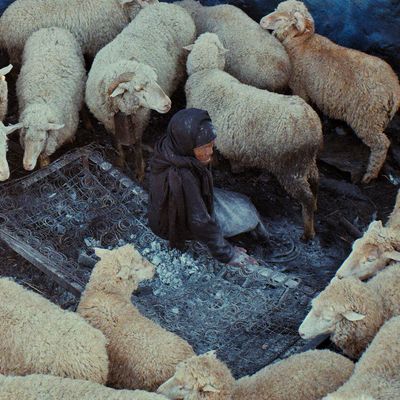
The carefully controlled frames of This Is Not a Burial, It’s a Resurrection have an unsettling permanence to them. Often, they contain elements of nature, such as a hill, a field, an ample stretch of sky. Usually, the camera is fixed, its gaze unflinching. At the center of that gaze, more often than not, we find Mantoa (Mary Twala Mhlongo), the film’s aging, grieving protagonist, the deep furrows on her face feeling less like signs of frailty and more like existential facts; she seems eternal, like the earth around her. Ironic, perhaps, since Mantoa is fighting a losing battle to save her village from being consumed by a dam project that will flood the whole area and render this world a thing of the past.
We know Mantoa’s battle against the forces of so-called progress is doomed because the film opens in a smoky, decrepit, vaguely sinister bar, as a man playing a lesiba (a traditional stringed wind instrument) reminisces about how this place was once called the Plains of Weeping, before Christian Europeans changed its name to Nasaretha. It might take a while before we realize that the dark, dank bar is the future of the film’s otherwise lush, bucolic setting; the foggy, dead-end transience of the joint seems like a rebuke to the earthy, timeless beauty of Mantoa’s world. As the storyteller speaks — whispering his words in a melodic daze, as if he’s been possessed by some spirit — Mantoa’s story unfolds before us, fable-like and elusive.
Written, directed, and edited by Lemohang Jeremiah Mosese, This Is Not a Burial, It’s a Resurrection became the first feature to screen at Sundance from the small African nation of Lesotho last year; I believe it’s now the first picture from that country to open theatrically in the U.S. (It had its world premiere at the 2019 Venice Film Festival.) That already makes it an intriguing landmark on its own, but the film is thrillingly new in other ways. It has the gripping, elemental hold of myth, but how Mosese tells the story is just as important as the story itself, maybe even more so. The picture is currently available virtually via dozens of independent theaters across the country, and is set to open at even more in the coming weeks. I recommend seeing it more than once; luckily, it’s so gorgeous and spellbinding that it invites repeat viewings.
Mantoa’s story begins with the death of her son on his way back from the gold mines in South Africa. (Lesotho is geographically embedded within South Africa, one of only three such “enclave countries” in the world, the other two being San Marino and Vatican City.) Having already suffered the deaths of her husband and every other member of her family, the distraught Mantoa now yearns for her own end. In what might be the film’s most moving sequence, she dons an elegant dress that her husband had given her, and beckons death, dancing slowly by herself, her hand gently holding an invisible partner — is it the spirit of her husband, her son, mortality itself? Her hands at times also look like they might even be cradling an imaginary child. So much of the film turns on such evocative inexactitude, on our ability to wonder (and wander) about the image.
Death does not come, and Mantoa is animated into action, beginning a crusade against the building of the dam and the imminent relocation of her fellow villagers. There is both practical and spiritual urgency to her quest. When she dies, she will be buried in the nearby cemetery, which will be lost when the floodwaters come. The village was founded during a time of plague by settlers who had to bury their loved ones in this spot. Death and life are inextricably intertwined here. (The earth doesn’t just contain bones, we’re told; it also contains umbilical cords and placenta.) Mantoa’s actions in turn spur the rest of the village to action. Thus, at the edge of extinction, the people of the Plains of Weeping (a.k.a. Nasaretha) experience a kind of resurrection.
Mosese depicts this transformation in subtle, cinematic ways: In the film’s early parts, even when Mantoa is among others, he usually films her by herself, isolating her within the shot. When she learns of her son’s death, for example, Mantoa looks like she’s talking to ghosts; it’s only later in the scene that we realize that there are other people there, hovering beyond the edges of the frame. As the film proceeds and her efforts gain traction, we begin to see Mantoa among others, finally part of a community starting to take collective action.
When I first saw This Is Not a Burial in Park City in 2020, I was struck (along with, I suspect, the rest of the audience) by 80-year-old Mary Twala Mhlongo’s sheer life force. Though she is playing a character submerged in grief and overwhelmed by her own impending mortality, there’s also stubborn, bedrock vitality to her performance. Black-clad and implacable, she’s filmed almost like an avenging angel.
The veteran actress passed away last July, and while this film is not her final credit (she appeared in Beyoncé’s Black Is King last summer), now the anxious, unyielding melancholy of her character hits harder. That we as a planet have ourselves suffered through unimaginable loss adds a further, unexpected resonance. For so many, the question “Where would you like to die?” is no longer abstract or speculative, but rather one of plaintive urgency. This Is Not a Burial, It’s a Resurrection would be an exceptional film under any circumstances, but it has a special power at this particular moment.


